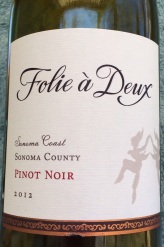Archive
WINE OF THE WEEK – Folie á Deux 2012 Sonoma Coast Pinot Noir
This is a delicious and affordable Pinot Noir from a winery that’s been making affordable, great-tasting wines for 30 years.

Sourced from the cool climate of the Sonoma Coast, the Folie á Deux 2012 Pinot Noir is 100-percent French oak-aged Pinot Noir
The wine is made from grapes sourced from the Sonoma Coast AVA, a Pacific Coast area with a half-million acres and six sub-AVAs stretching from San Pablo Bay north to Mendocino County.
That cool climate shows in the wine’s smooth mouthfeel and flavors of juicy cranberry and baked cherry flavors with a bit of toast and enough acidity to enliven the palate.
Founded by two psychiatrists, Folie á Deux made a quick impression when the first wine, a 1983 Chardonnay, beat 1,400 other entries for “Best of Show” at the California State Fair Wine Competition.
After the two founders separated in the early 1990s, the winery was sold in 1995 to a group headed by renowned winemaker, Dr. Richard Peterson.
Peterson revived the winery, bringing on wine industry veteran Scott Harvey (he created the Menage á Trois line of wines) as winemaker for Folie á Deux.
In 2004, Folie á Deux was sold to Sutter Home/Trinchero Winery.
Folie á Deux 2012 Sonoma County Pinot Noir $20 SRP
Enjoying the oldest winery in Italy
I was wandering the aisles of Crossroads Liquors when owner and friend Jerry Sica stopped to ask if I had anything in particular in mind.
“Other than a Chianti or Tempranillo, no,” I said, and he unhesitatingly pointed me toward the Barone Ricasoli Brolio 2010 Chianti Classico.

A line-up of Ricasoli wines from a tasting at La Quercia in New York City. Photo courtesy of Cherries and Clay.com.
“You know these guys” he asked, and I nodded.
I was familiar with the Ricasoli family of wines, having met the current (and 32nd) Barone, Franceso, at VinItaly a few years ago.
Although I didn’t know it before our meeting, Barone Ricasoli is the oldest winery in Italy and, according to the magazine Family Business, the fourth longest-lived company in the same place and the second such in the wine sector.
My friend hauling me around VinItaly told me a bit about the Ricasoli history, including the Ricasoli family ties with the town of Florence going back to the 12th century, and where they still spend the summer in the family castle at Brolio, in the hills between Siena and Florence.
He also noted it was the Barone Bettino Ricasoli, known as the “Iron Baron,” who is credited with first writing the Sangiovese-based formula for Chianti Classico wines in 1872.
We finally stopped at stopped at one booth and, pointing to the by-now famiiar name, he asked, “How do you pronounce that?”
After I had stumbled a few times through my deficient Italian, he looked dismayed, grunted, “How very American,” and corrected my pronunciation.
He then guided me over to meet the Barone and with a hiss, warned, “Try not to say anything too American.”
Chianti Classico rules allow up to 20 percent of non-Sangiovese red grapes and both the Brolio Chianti Classico and its big brother, the Ricasoli Castello di Brolio Chianti Classico, typically are 80 percent Sangiovese, 15 percent Merlot and 5 percent Cabernet Sauvignon.
Both wines are ruby red, with violets, red fruit and cherry notes amid earthy Sangiovese minerality with a hint of spice on the end.
If you pay attention to such things, the wines received 90 points from both The Wine Advocate and the International Wine Cellar.
The Ricasoli website says the 2010 vintage is “the best Sangiovese we have ever seen.”
Which, coming from a winery dating back to 1141, is something notable.
For more about Ricasoli Brolio Chianti Classico, please see what my friend and fellow blogger Susannah Gold, who also was at that edition of VinItaly, has written on her blog, avvinare.
Barone Ricasoli Brolio 2010 Chianti Classico, $25; Castello Brolio Chianti Classico, $45. Prices may vary.
One other note: The ribbon on the label insignia says “Rien sans Peine,” which translates from the French to “Nothing without pain.”
Or, as Americans are wont to say, “No pain, no gain.”
Note: Photo courtesy of Cherries and Clay.com.